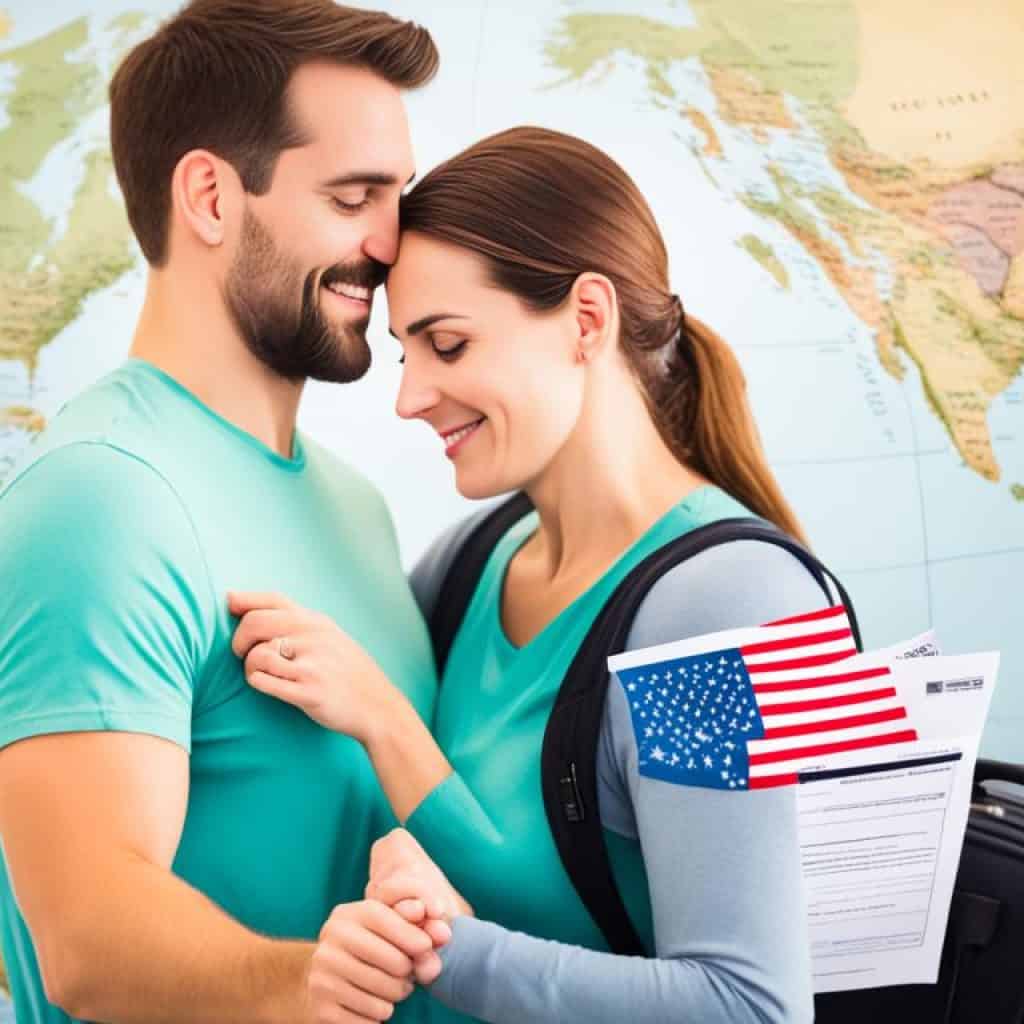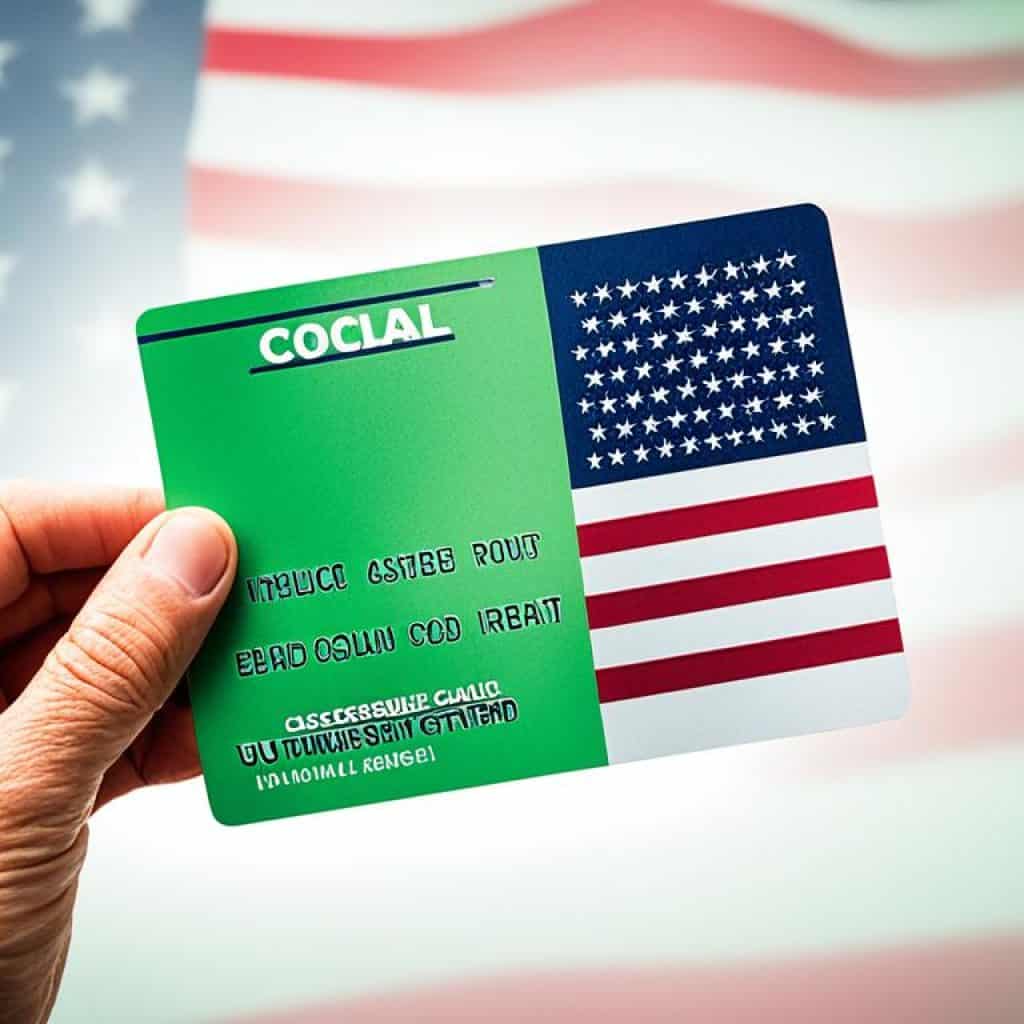Are you a U.S. citizen married to a foreign national? Navigating the immigration process can be a daunting task, with multiple options and requirements to consider. But what if there was a way to simplify this process and bring your spouse to the United States smoothly?
In this article, we will explore the U.S. Citizen Petition For Spouse and its various options, including Adjustment of Status, Consular Processing, and the Fiancé Visa. We will delve into the eligibility criteria, required documentation, and application processes for each option. Whether you are already married or planning a future wedding, understanding these avenues will help you make an informed decision tailored to your unique circumstances.
Key Takeaways:
- There are three main options for U.S. citizens petitioning for a spouse: Adjustment of Status, Consular Processing, and the Fiancé Visa.
- Each option has its own set of requirements, advantages, and disadvantages.
- Couples should carefully consider their circumstances and choose the best option for their situation.
- Documentation is a crucial component of the U.S. spouse visa application process.
- Understanding the processes involved can help simplify the journey of uniting with your spouse in the United States.
Adjustment of Status (AOS)
Adjustment of Status (AOS) is a process that allows foreign nationals who are married to U.S. citizens to obtain lawful permanent residency in the United States. This option eliminates the need for the foreign national spouse to leave the country to apply for an immigrant visa.
To be eligible for AOS based on marriage, the U.S. citizen spouse must provide proof of citizenship, such as a birth certificate or naturalization certificate. The foreign national spouse must have entered the U.S. lawfully and without any conditions that would make them inadmissible.
The AOS application requires several forms, including the I-485, I-130, and I-864. These forms are used to establish the marital relationship, provide financial sponsorship, and demonstrate eligibility for adjustment of status. Supporting documents such as marriage certificates, evidence of the genuine relationship, and medical examination results must be included as well.
The AOS application process involves filing the necessary petitions, attending biometrics and background checks, participating in interviews, and waiting for a decision. While AOS offers the convenience of remaining in the United States during the process and the potential for employment authorization, it does come with some disadvantages. These include limited mobility while the application is pending and longer processing times compared to consular processing.
“Obtaining a green card through Adjustment of Status provides an opportunity for foreign spouses to establish permanent residency in the United States, without needing to leave the country. It’s a convenient option that allows couples to stay together throughout the process.”
Overall, Adjustment of Status offers a streamlined path to permanent residency for foreign nationals married to U.S. citizens. By understanding the eligibility criteria, preparing the required documentation, and navigating the application process, couples can pursue their American dreams together.
Consular Processing
Consular Processing is the preferred option for U.S. citizens who are married to foreign nationals residing outside the United States. This process involves applying for an immigrant visa at a U.S. consulate or embassy in the foreign spouse’s home country.
Eligibility criteria and required documentation for consular processing are similar to Adjustment of Status (AOS), with a few additional forms and specific civil documents. The applicant must provide forms like DS-260, along with supporting documents such as marriage certificates and evidence of relationship.
Application Process
The application process for consular processing includes several steps:
- Filing petitions
- Waiting for visa availability
- Paying fees
- Undergoing a medical examination
- Attending a visa interview
- Receiving a visa issuance
During the consular interview, the applicant will answer questions related to their eligibility and relationship with the U.S. citizen spouse. It is essential to provide all required documentation and answer questions truthfully and confidently.
“Consular processing offers faster processing times for spouses residing outside the U.S. and ensures certainty upon entry. It is an efficient way for couples to unite in the United States.”
However, consular processing has its disadvantages. Geographic limitations may make it challenging for spouses residing far away from a U.S. consulate or embassy. Additionally, consular interviews and applications involve multiple agencies, which may result in increased scrutiny.
| Advantages of Consular Processing | Disadvantages of Consular Processing |
|---|---|
| 1. Faster processing for non-U.S. resident spouses | 1. Geographic limitations |
| 2. Certainty upon entry | 2. Increased scrutiny during interviews |
By understanding all the requirements and following the proper application process, couples can navigate consular processing successfully and reunite with their spouse in the United States.
Fiancé Visa (K-1)
The Fiancé Visa, also known as the K-1 Visa, is a special visa category that allows U.S. citizens to bring their foreign fiancés to the United States for the purpose of getting married. This visa is specifically designed for couples who plan to marry in the United States and provides a pathway for the foreign fiancé to obtain legal residency in the country. The Fiancé Visa process involves several key steps:
- Submit Form I-129F Petition: The U.S. citizen must first submit a Form I-129F petition to the U.S. Citizenship and Immigration Services (USCIS). This form serves as a request to bring the foreign fiancé to the U.S. and includes details about the couple’s relationship.
- Wait for Approval: After submitting the petition, the couple must patiently wait for its approval. The USCIS will review the petition and determine its validity. Once approved, the case is transferred to the National Visa Center (NVC) for further processing.
- Visa Application at the Consulate or Embassy: Once the petition is approved, the foreign fiancé will need to apply for the K-1 Visa at the appropriate U.S. consulate or embassy in their home country. The application involves filling out forms, providing supporting documents, and paying visa fees.
- Medical Examinations: As part of the visa application process, the foreign fiancé will be required to undergo medical examinations to ensure they meet the health requirements set by the U.S. government.
- Visa Interview: Following the medical examinations, the foreign fiancé will attend an interview at the consulate or embassy. During the interview, the consular officer will ask questions to assess the validity of the relationship and determine if the visa should be granted.
- Marriage in the United States: Once the visa is approved, the foreign fiancé can travel to the United States. However, it is important to note that the couple must marry within 90 days of the fiancé’s entry into the country.
It’s worth noting that the Fiancé Visa has several advantages. It allows U.S. citizens to bring their foreign fiancés to the United States, ensuring that they can be together during the marriage process. Additionally, it provides a clear pathway for the foreign fiancé to obtain legal residency and ultimately apply for a Green Card. However, one potential disadvantage of the Fiancé Visa is the time constraint for getting married within 90 days of entry.

Overall, the Fiancé Visa (K-1 Visa) offers an opportunity for U.S. citizens to sponsor their foreign fiancés and begin their journey towards marriage in the United States. By navigating the visa process and meeting all requirements, couples can strengthen their relationship and start their life together in their new home country.
Family-Based Green Card Categories
Family-based green card categories play a crucial role in determining who is eligible to sponsor a family member for a green card. These categories are divided into immediate relatives and preference categories, each with its own set of criteria.
Immediate Relatives
Immediate relatives have the advantage of unlimited visa availability, which means there are no annual limits or wait times. The immediate relative category includes spouses of U.S. citizens and unmarried children under 21 years of age. These qualifying relationships make it easier for immediate relatives to obtain a green card and join their family members in the United States.
Preference Category
Unlike immediate relatives, other family members fall into the preference category. This category has annual limits and may involve potential wait times. The preference category includes different qualifying relationships based on the type of family member and their relationship to the U.S. citizen or permanent resident.
| Qualifying Relationship | Family Member |
|---|---|
| Unmarried Sons and Daughters | of U.S. citizens |
| Spouses and Unmarried Children | of Permanent Residents |
| Married Sons and Daughters | of U.S. citizens |
These preference categories are subject to annual limits and may involve waiting periods depending on the demand and available visa numbers. Spouses and unmarried children of permanent residents, unmarried sons and daughters of U.S. citizens, and married sons and daughters of U.S. citizens fall into these preference categories.
Understanding the different family-based green card categories can help individuals determine their eligibility and the potential timeline for obtaining a green card for their family members.
Green Card for Immediate Relatives of U.S. Citizens
Immediate relatives of U.S. citizens, including spouses, unmarried children under 21, and parents of U.S. citizens, have an unlimited supply of green cards available. They can apply for a green card through the Form I-130 petition and do not have to wait in line for a visa number to become available.
If you are the spouse of a U.S. citizen, an unmarried child under 21 years old, or a parent of a U.S. citizen, you have a unique advantage when it comes to obtaining a green card. Unlike other family-based categories, immediate relatives do not face the limitations of visa quotas, which often result in long wait times.
To apply for a green card as an immediate relative, you will need to file the Form I-130 Petition for Alien Relative. This form serves as proof of your qualifying relationship to the U.S. citizen and initiates the green card application process. Once approved, you can proceed with the next steps in obtaining your green card, such as submitting additional forms and supporting documents.
It’s important to note that if you are an immediate relative child under 21 and you get married, your classification will change to a different family-based category. This change may affect your eligibility and place you in a preference category with limited visa availability.
If you qualify as an immediate relative of a U.S. citizen, consider yourself fortunate. The process of obtaining a green card is generally faster and more straightforward compared to other family-based categories. Take advantage of this opportunity to reunite with your loved ones and start your new life in the United States.
| Immediate Relatives | |
|---|---|
| Spouse of U.S. Citizen |
|
| Unmarried Child Under 21 |
|
| Parent of U.S. Citizen |
|
“The reunification of immediate relatives is of utmost importance to provide stability and support for families in the United States. By eliminating wait times and visa quotas for this category, we prioritize the unity and well-being of U.S. citizens and their closest family members.”
Green Card for Other Family Members of U.S. Citizens
Family members of U.S. citizens who do not qualify as immediate relatives fall into the preference category. This category includes unmarried adult sons and daughters, married children, and brothers and sisters of adult U.S. citizens. The preference category has limits on the number of green cards issued each year, resulting in potential wait times.
Preference Category Eligibility
In the preference category, unmarried adult sons and daughters of U.S. citizens, married children of U.S. citizens, and brothers and sisters of adult U.S. citizens can apply for a green card through their U.S. citizen sibling or parent’s sponsorship.
Wait Times in the Preference Category
Due to the annual limits on green cards issued in the preference category, there may be wait times for family members to receive their green cards. The wait times can vary depending on factors such as the individual’s relationship to the U.S. citizen and the country of chargeability. It is important to stay up to date with the Visa Bulletin, which provides information on visa availability and priority dates.
| Family Relationship | Preference Category | Annual Limit |
|---|---|---|
| Unmarried Adult Sons and Daughters of U.S. Citizens | F1 | 23,400 |
| Married Children of U.S. Citizens | F3 | 23,400 |
| Brothers and Sisters of Adult U.S. Citizens | F4 | 65,000 |
The table above provides an overview of the preference categories for family-based green cards and their annual limits. These limits contribute to the potential wait times for green card issuance.
Special Considerations
It is important to note that in the preference category, there are certain considerations for unmarried sons and daughters. If an unmarried son or daughter under 21 years of age gets married, their classification changes to a different category, potentially affecting their eligibility for a green card in the preference category.
A successful green card application in the preference category requires careful consideration of eligibility criteria, documentation, and understanding the potential wait times. By staying informed and partnering with an experienced immigration attorney, individuals can navigate the green card process for their family members smoothly and efficiently.

Green Card for Family Members of a Permanent Resident
As a permanent resident of the United States, you have the opportunity to petition for certain family members to obtain a green card. This includes your spouse and unmarried child, allowing them to join you as lawful permanent residents.
However, it’s important to note that there is a cap on the number of green cards issued each year, and there may be wait times involved. This is due to the family preference category system, which prioritizes certain family relationships for immigration purposes.
Despite the potential wait times, sponsoring your spouse or unmarried child for a green card as a permanent resident can bring your family closer together and provide them with the opportunity to build a future in the United States.
Family Preference Category
The family preference category is designed to allocate green cards to specific family relationships based on the type of family member and their relationship to the petitioner. As a permanent resident, you fall under the second family preference category (F2).
The F2 category includes spouses and unmarried children (under 21 years old) of permanent residents. While the immediate relatives of U.S. citizens have unlimited visa availability, the family preference category has annual limits, which can result in longer waiting periods for green card issuance.
It’s important to understand that the exact length of the wait time can vary and is influenced by factors such as the petitioner’s country of origin and the number of available visas. Therefore, it’s necessary to stay up-to-date with visa bulletin updates issued by the U.S. Department of State.
Spouse and Unmarried Child
As a permanent resident, you can sponsor both your spouse and unmarried child for a green card. Your spouse will be eligible as long as your marriage is legally recognized. For your unmarried child, they must be under the age of 21 and unmarried at the time of the petition.
When petitioning for their green card, you will need to file the appropriate USCIS forms, such as the Form I-130, Petition for Alien Relative. It’s essential to provide accurate and complete documentation to support the relationship and ensure the smooth processing of their application.
While there may be waiting times involved, obtaining a green card for your spouse and unmarried child as a permanent resident can bring your family together and provide them with the opportunities and benefits that come with permanent resident status in the United States.
Priority Date and Visa Availability
Once a Form I-130 petition is approved, the spouse is placed on an immigration visa waiting list with a priority date. The waiting period for a visa to become available varies based on the priority date and the spouse’s home country. The State Department’s Visa Bulletin provides information on current priority dates.
| Home Country | Priority Date | Visa Availability |
|---|---|---|
| China | July 1, 2021 | Unavailable |
| India | March 15, 2022 | Unavailable |
| Mexico | October 30, 2020 | Available |
| Philippines | May 23, 2021 | Available |
| United Kingdom | April 5, 2022 | Unavailable |
Application Process After Visa Availability
Once the priority date becomes current, the next step in the U.S. spouse visa journey is the application process. Let’s explore the various stages involved in this process.
Submission to the National Visa Center (NVC)
After the priority date becomes current, the spouse can submit a visa application form to the National Visa Center (NVC). This form is a crucial step in moving forward with the visa processing.
Remember to carefully complete and provide all necessary documentation along with your visa application form. A well-prepared application can help streamline the processing time.
Visa Processing through the NVC
Once the NVC receives the visa application, the processing period begins. Visa processing through the NVC typically takes several months.
During this time, the NVC reviews the submitted documents and verifies their authenticity. It is important to ensure that all required documentation is accurate and up to date.
Forwarding to the Consulate or Embassy
Following the completion of visa processing at the NVC, the visa file is then forwarded to the consulate or embassy nearest to the spouse’s location. This step is crucial as it marks the transition from the initial processing stage to the final stages of the visa application.
The processing time at the consulate or embassy may vary depending on various factors but can take up to three months on average.
Visa Interview
Once the visa application has reached the consulate or embassy, a visa interview is scheduled. During the interview, the spouse is required to provide supporting documentation and answer questions related to their visa application.
Remember to be well-prepared for the visa interview. Practice answering potential questions, gather all necessary supporting documents, and dress appropriately to make a positive impression.
Immigration Visa Issuance
If the visa interview is successful and all necessary requirements are met, the spouse will receive an immigration visa. This visa grants entry into the United States and is a significant step towards the final goal of obtaining a green card.
Now that we have explored the application process after visa availability, let’s move on to the next section, which covers the entry into the United States and Green Card issuance.
Entry to the United States and Green Card Issuance
Once the spouse receives the immigration visa, they can embark on the exciting journey of traveling to the United States to reunite with their U.S. citizen partner. Upon arrival, the spouse must present their visa at the designated port of entry, where they will go through the necessary immigration checks and procedures.
After successfully entering the United States, the spouse eagerly waits for their Green Card to arrive. Typically, the Green Card is mailed to the spouse’s address within several weeks. This essential document serves as official proof of their status as a lawful permanent resident in the United States.

If the marriage between the U.S. citizen and the immigrant spouse is less than two years old at the time of Green Card issuance, the Green Card will be conditional. This means that the spouse will receive a Green Card that is valid for a temporary period of two years. To transition to a permanent Green Card, the conditional resident must take further action by filing Form I-751, Petition to Remove Conditions on Residence.
Form I-751 is essential for the immigrant spouse to demonstrate that their marriage remains bona fide and not solely for immigration purposes. It is crucial to submit this form within the 90-day window before the expiration of the conditional Green Card.
| Steps for Form I-751 | Requirements |
|---|---|
| Complete Form I-751 | – Provide details about the marriage – Include supporting evidence – Pay the filing fee |
| Submit the Form | – Mail the form to the appropriate USCIS address – Follow specific instructions provided by USCIS |
| Biometrics Appointment | – Attend a biometrics appointment to provide fingerprints and photographs |
| Wait for USCIS Decision | – USCIS reviews the petition – May request an interview if additional evidence is needed – Decision on whether to remove conditions |
| Green Card Issuance | – If approved, the spouse receives a new, permanent Green Card |
It is important to ensure all necessary documentation and evidence are included with the Form I-751 petition. This includes joint financial documents, joint residential documents, and any other proof of the ongoing marital relationship.
The USCIS will review the submitted Form I-751 petition and make a decision on whether to remove the conditions on the spouse’s residence. If approved, the conditional resident will receive a new Green Card, valid for ten years, providing them with permanent resident status in the United States.
It is crucial to carefully follow the instructions and requirements throughout the Form I-751 process to ensure a successful outcome in obtaining a permanent Green Card.
Processing Time for Spouses of Permanent Residents and U.S. Citizens
When it comes to the immigration process for spouses of permanent residents and U.S. citizens, the processing time can vary depending on several factors. These factors include the petitioner’s citizenship status and the specific USCIS service center responsible for processing the Form I-130 petition.
On average, the immigration process for a spouse of a permanent resident takes approximately 24 to 36 months. This waiting period can be attributed to the higher demand for visas in this category and the limited number of visas available each year.
For spouses of U.S. citizens, the processing time is typically shorter, ranging from about 12 to 18 months. U.S. citizens have priority when it comes to visa availability, resulting in a faster processing time compared to the preference category for permanent residents.
It’s important to note that these processing times are averages and can vary based on individual circumstances and external factors. It’s always best to consult with the USCIS and stay updated on current processing times in order to have a better understanding of the timeline for your spouse’s immigration application.
Factors Affecting Processing Time:
- USCIS service center processing the Form I-130 petition
- Current demand for visas in the specific category
- Individual circumstances and complexity of the case
Note: The processing time may vary and is subject to change. Always consult the USCIS website or speak to an immigration attorney for the most up-to-date information.
Financial Sponsorship and Forms
As the petitioner in the U.S. Citizen Petition For Spouse process, it is crucial to understand the importance of financial sponsorship and the necessary forms involved. One vital form that demonstrates your commitment to supporting your immigrating spouse is Form I-864.
Form I-864, also known as the Affidavit of Support Under Section 213A of the INA, serves as a legally binding contract between the petitioner and the U.S. government. By filing this form, you are providing assurance that you have the financial means to support your spouse and prevent them from becoming a public charge.
It is essential to note that financial sponsorship goes beyond simply completing the form. It signifies your willingness to take on the financial responsibility of ensuring your spouse’s well-being during their immigration journey and helps establish their eligibility for an immigrant visa or adjustment of status.
Key points to remember when considering financial sponsorship:
- Form I-864 must be filed by the petitioner, who is the U.S. citizen or permanent resident sponsoring their spouse’s immigration.
- The form requires detailed information about your income, assets, and liabilities to demonstrate your financial stability.
- The petitioner’s income must meet the minimum income requirement specified by the U.S. Department of Health and Human Services Poverty Guidelines.
By submitting Form I-864, you are making a legally binding commitment to provide financial support to your immigrating spouse until they become a U.S. citizen, work for at least ten years, pass away, or lose their permanent resident status.
This commitment includes financial support for basic needs, such as housing, food, and healthcare, as well as repayment of any means-tested public benefits that your spouse may receive.
It is important to fulfill your financial sponsorship obligation to ensure the smooth progression of your spouse’s immigration process. Failure to meet these responsibilities could jeopardize their application and potentially result in immigration consequences.
By demonstrating financial stability through Form I-864 and fulfilling your commitment as the supporting spouse, you are laying a strong foundation for your spouse’s successful immigration journey to the United States.
To learn more about Form I-864 and the financial sponsorship requirements, visit the official U.S. Citizenship and Immigration Services (USCIS) website.
Affidavit of Support: A Binding Commitment
“Financial sponsorship through Form I-864 is an essential component of the U.S. Citizen Petition For Spouse process. By signing this form, the petitioner not only provides financial assurance but also shows the U.S. government their commitment to supporting their immigrating spouse throughout the immigration journey.”
Conclusion
The U.S. Citizen Petition For Spouse process offers couples different options to navigate the journey of obtaining a U.S. spouse visa. These options include Adjustment of Status, Consular Processing, and the Fiancé Visa. Each option has its own set of requirements, processing times, and advantages. It is crucial for couples to carefully evaluate their circumstances and choose the option that best suits their situation.
By thoroughly understanding the process and gathering the necessary documentation, couples can simplify the U.S. spouse visa journey. They can take proactive steps to ensure a smooth and efficient process of reuniting with their spouse in the United States. Whether it’s pursuing Adjustment of Status, Consular Processing, or the Fiancé Visa, couples can eliminate uncertainties by being well-informed and prepared.
Deciding on the most suitable option requires careful consideration, but with the right approach, couples can successfully navigate the complexities of the U.S. Citizen Petition For Spouse process. From choosing between Adjustment of Status and Consular Processing to determining eligibility for the Fiancé Visa, couples can make informed decisions that support their goal of reuniting with their spouse in the United States.
By taking a proactive approach, understanding the options, and gathering the necessary documentation, couples can simplify the U.S. spouse visa process and move forward toward their goal of living together in the United States.
FAQ
What is the Adjustment of Status (AOS)?
Adjustment of Status (AOS) allows foreign nationals married to U.S. citizens to become lawful permanent residents of the United States through a petition process.
What are the eligibility criteria for AOS?
The U.S. citizen spouse must have proof of citizenship, while the foreign national spouse must have entered the U.S. lawfully and not have any conditions making them inadmissible.
What documents are required for AOS?
Required documentation includes forms such as I-485, I-130, and I-864, as well as supporting documents like marriage certificates, evidence of relationship, and medical examination results.
How does the AOS application process work?
The AOS application process involves filing petitions, attending biometrics and background checks, participating in interviews, and receiving a decision.
What are the advantages of AOS?
Advantages of AOS include convenience and potential employment authorization.
What are the disadvantages of AOS?
Disadvantages of AOS include limited mobility and longer processing times compared to consular processing.
What is Consular Processing?
Consular Processing is the usual route for U.S. citizens who marry foreign nationals residing outside the U.S., involving applying for an immigrant visa at a U.S. consulate or embassy in the foreign spouse’s home country.
What are the eligibility criteria for Consular Processing?
The eligibility criteria for Consular Processing are similar to AOS, with the addition of forms like DS-260 and specific civil documents.
What documents are required for Consular Processing?
Required documentation for Consular Processing includes forms such as I-130 and DS-260, as well as specific civil documents.
How does the Consular Processing application process work?
The Consular Processing application process includes filing petitions, waiting for visa availability, paying fees, undergoing a medical examination, attending a visa interview, and receiving a visa issuance.
What are the advantages of Consular Processing?
Advantages of Consular Processing include faster processing for spouses outside the U.S. and certainty upon entry.
What are the disadvantages of Consular Processing?
Disadvantages of Consular Processing include geographic limitations, increased scrutiny during interviews, and involvement of multiple agencies.
What is the Fiancé Visa (K-1)?
The Fiancé Visa, also known as the K-1 Visa, allows U.S. citizens to bring their foreign fiancés to the U.S. for the purpose of marriage.
How does the Fiancé Visa (K-1) process work?
The Fiancé Visa process involves submitting the Form I-129F petition, waiting for approval, and then proceeding with the visa application at the consulate or embassy.
What are the advantages of the Fiancé Visa (K-1)?
Advantages of the Fiancé Visa include the ability to bring a fiancé to the U.S. for marriage.
What is a Family-Based Green Card?
A Family-Based Green Card is a way for U.S. citizens and permanent residents to sponsor their family members for permanent residency in the United States.
Who are considered Immediate Relatives of U.S. Citizens?
Immediate relatives of U.S. citizens include spouses, unmarried children under 21, and parents of U.S. citizens.
What is the eligibility for the Green Card for Immediate Relatives of U.S. Citizens?
Immediate relatives of U.S. citizens have an unlimited supply of green cards available and do not have to wait in line for a visa number.
Who falls into the Preference Category for Family-Based Green Cards?
Other family members of U.S. citizens and permanent residents fall into the Preference Category, which includes unmarried adult sons and daughters, married children, and brothers and sisters of adult U.S. citizens.
What is the eligibility for the Green Card for Other Family Members of U.S. Citizens?
Other family members of U.S. citizens in the Preference Category have wait times for visa numbers to become available.
Who can a Permanent Resident petition for a Green Card?
Permanent residents can petition for their spouse and unmarried child.
What is the Priority Date and Visa Availability?
Once a Form I-130 petition is approved, the spouse is placed on an immigration visa waiting list with a priority date. The waiting period for a visa to become available varies based on the priority date and the spouse’s home country.
What is the application process after visa availability?
Once the priority date becomes current, the spouse can submit a visa application form to the National Visa Center (NVC), which forwards the visa file to the consulate or embassy nearest to the spouse for processing.
How long does it take for the spouse to enter the United States and receive a Green Card?
The processing time for entry to the United States and Green Card issuance varies but can take several months.
How long does the immigration process take for spouses of permanent residents and U.S. citizens?
The processing time for a spouse’s immigration application depends on various factors, with an average processing time of about 24 to 36 months for spouses of permanent residents and 12 to 18 months for spouses of U.S. citizens.
What is the Financial Sponsorship and Forms requirement?
The petitioner must provide financial sponsorship by filing Form I-864, which demonstrates the petitioner’s commitment to financially support the immigrating spouse throughout the immigration process.








Add comment